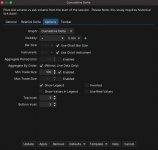For Context:
I’ve transitioned from TradingView to MotiveWave to leverage Rithmic’s MBO data for advanced order-flow analysis. My strategy relies heavily on Cumulative Volume Delta (CVD) to identify institutional exhaustion/absorption. I'd be grateful for some guidance on the following settings:
I’ve transitioned from TradingView to MotiveWave to leverage Rithmic’s MBO data for advanced order-flow analysis. My strategy relies heavily on Cumulative Volume Delta (CVD) to identify institutional exhaustion/absorption. I'd be grateful for some guidance on the following settings:
- Aggregation settings: "Aggregate by Order" and/or "Aggregate by Period" (milliseconds).
- Minimum Trade Size: (e.g., 100+ contracts RTH).
Specific Questions:
- Aggregate by Order:
- Does this only consolidate multi-leg executions (e.g., 500-lot order → single delta entry), or does it also filter out trades below the "Minimum Size" threshold?
- If it doesn’t filter, what’s the functional difference between enabling/disabling this?
- Aggregate by Period:
- How does millisecond aggregation (e.g., 100ms) affect delta calculation? Does it smooth delta within a candle or alter the net delta value? Something else?
- Interaction with Minimum Size:
- Is the "Minimum Size" filter applied before or after aggregation?
- Example: If I set "Min Size = 100," will a 75+25-lot order be:
- Filtered out?
- Aggregated into 100 and displayed?
- Treated as two separate trades (75 filtered, 25 shown)?
- Visual Impact:
- Why does the CVD candle’s appearance remain identical whether aggregation is enabled/disabled? Shouldn’t aggregated orders create taller/smoother candles?
Why This Matters:
- Strategy Dependency: I use CVD engulfing candles/divergence for entries. If aggregation alters delta dynamics, my signals may be misread.
- MBO Advantage: I want to exploit Rithmic’s true aggressor data—but only if I understand what the study outputs.

